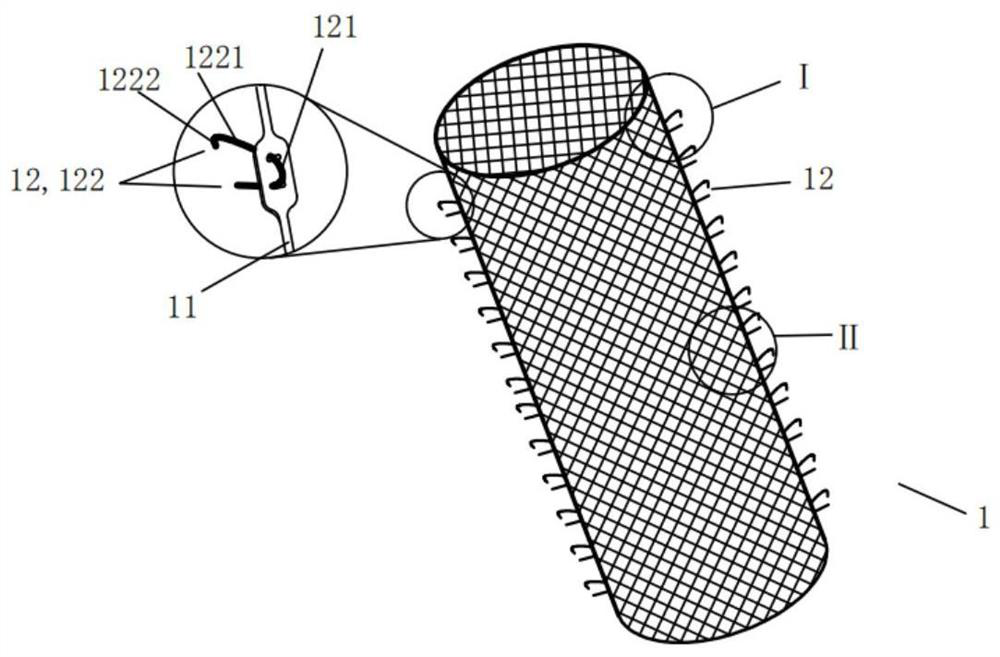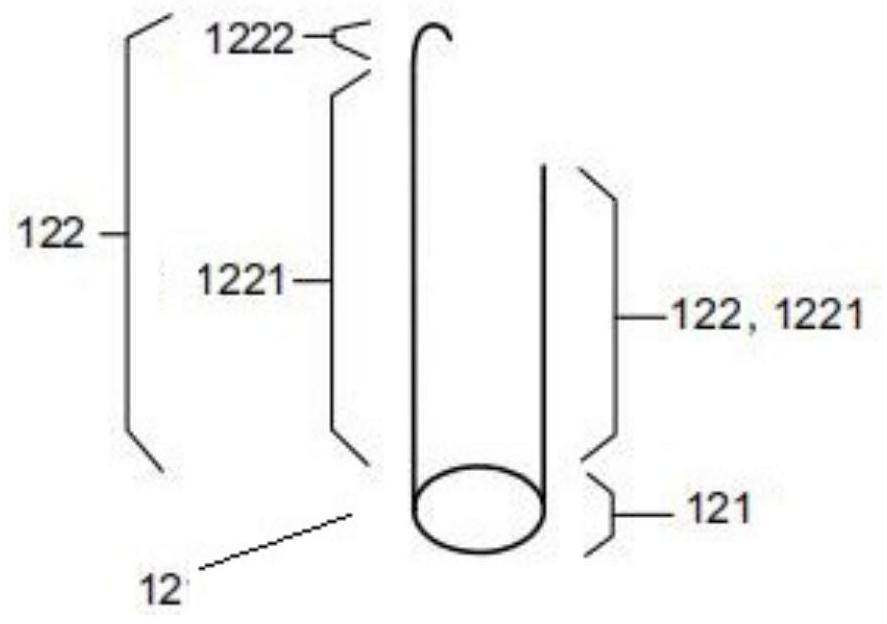Dense net support with bionic micro-thorn attachment structures
A technology of dense mesh and flat structure, applied in the field of dense mesh stents, can solve the problems of large axial elongation, difficulty in precise positioning, and easy displacement of stents, and achieve the effects of increasing roughness, enhancing adhesion, and increasing constraints
- Summary
- Abstract
- Description
- Claims
- Application Information
AI Technical Summary
Problems solved by technology
Method used
Image
Examples
Embodiment 1
[0072] Such as figure 1 As shown, a dense mesh support 1 with a bionic micro-thorn attachment structure provided by the present invention includes an elastic skeleton 11 and a plurality of bionic micro-thorn attachment structures 12. The area of the cell is 0.1 to 10mm 2 , the grid is dense and tiny, the skeleton has excellent radial compressibility, radial ductility and bending flexibility, and its diameter can be expanded from a few millimeters to tens of millimeters, not only easy to compress in the delivery sheath before operation, It can also fully fit the inner wall of the lumen when it is released during the operation, especially in some complex curved lumens with small bending radii. Morphological adaptability. The bionic micro-thorn attachment structure 12 is arranged on the outer surface of the skeleton 11. The shape of the bionic micro-thorn attachment structure 12 is the sparse micro-thorns on the surface of the imitation plant. The bionic micro-thorn attachmen...
Embodiment 2
[0081] Based on the first embodiment, the design of the limiting mechanism 123 in the second embodiment is different from that in the first embodiment. In one embodiment, the limiting mechanism 123 is one or more combinations of a local constriction structure, a local protrusion structure, and a wave structure arranged on the skeleton 11, wherein the wave structure is a two-dimensional plane or a three-dimensional three-dimensional shape. One or more combinations of folding structure and serpentine structure, respectively as Figure 13 a to Figure 13 As shown in d, the bionic microthorn attachment structure 12 is formed by winding and connecting the elastic and shape-memory wire with the limit mechanism 123, wherein part of the wire is wound on the limit mechanism 123, and the free wire end to form micro-thorns 122, and the wire material involved in winding at this time is the thorn roots 121, such as Figure 14 shown. In another embodiment, the limit mechanism 123 include...
Embodiment 3
[0083] Based on Embodiment 1, the difference between Embodiment 3 and Embodiment 1 is that the skeleton 11 is made of multiple wires with elasticity and shape memory through weaving and shaping up and down, and any bionic micro-thorn attachment structure 12 is composed of a It is made of silk with elasticity and shape memory, and some or all of the wires that make the skeleton 11 are intertwined with some of the wires that make the bionic micro-thorn attachment structure 12 to achieve fixed connection. In the intertwined area The plurality of wave structures formed by the wire material for making the skeleton 11 is the limit mechanism 123, and the multiple wave structures formed by the wire material for making the bionic micro-thorn attachment structure 12 are the thorn roots 121. The free end of the wire forms micro-thorns 122. Preferably, the corrugated structure is a spatial structure formed by twisting and winding multiple wires, such as Figure 17 shown.
PUM
| Property | Measurement | Unit |
|---|---|---|
| Area | aaaaa | aaaaa |
Abstract
Description
Claims
Application Information
 Login to View More
Login to View More - R&D
- Intellectual Property
- Life Sciences
- Materials
- Tech Scout
- Unparalleled Data Quality
- Higher Quality Content
- 60% Fewer Hallucinations
Browse by: Latest US Patents, China's latest patents, Technical Efficacy Thesaurus, Application Domain, Technology Topic, Popular Technical Reports.
© 2025 PatSnap. All rights reserved.Legal|Privacy policy|Modern Slavery Act Transparency Statement|Sitemap|About US| Contact US: help@patsnap.com



